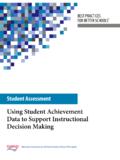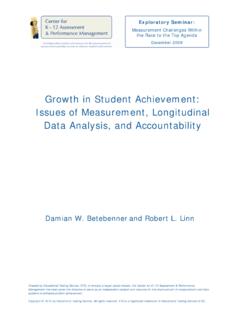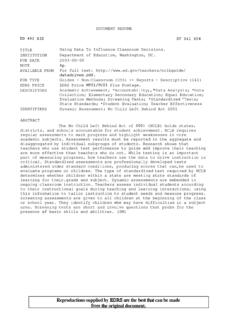Transcription of NATIONAL BUREAU OF ECONOMIC RESEARCH DATA …
1 NBER WORKING PAPER SERIESIDENTIFYING EFFECTIVE CLASSROOM PRACTICES using STUDENT ACHIEVEMENTDATAT homas J. KaneEric S. TaylorJohn H. TylerAmy L. WootenWorking Paper 15803 BUREAU OF ECONOMIC RESEARCH1050 Massachusetts AvenueCambridge, MA 02138 March 2010 Authors are listed alphabetically. The authors would like to thank Douglas Staiger, Ron Ferguson,and participates at the Brown University seminar on Race and Inequality, the Program on EducationPolicy and Governance Colloquium at Harvard University, and The Institute for RESEARCH on EducationPolicy and Practice Speaker Series at Stanford University for helpful comments on previous draftsof this paper. We also acknowledge the Joyce Foundation for their generous support of this project,as well as the cooperation and support of the Cincinnati Public Schools.
2 The views expressed hereinare those of the author(s) and do not necessarily reflect the views of the NATIONAL BUREAU of working papers are circulated for discussion and comment purposes. They have not been peer-reviewed or been subject to the review by the NBER Board of Directors that accompanies officialNBER publications. 2010 by Thomas J. Kane, Eric S. Taylor, John H. Tyler, and Amy L. Wooten. All rights sections of text, not to exceed two paragraphs, may be quoted without explicit permission providedthat full credit, including notice, is given to the Effective Classroom Practices using Student achievement DataThomas J. Kane, Eric S. Taylor, John H. Tyler, and Amy L. WootenNBER Working Paper No. 15803 March 2010 JEL No.
3 I21,J45 ABSTRACTR ecent RESEARCH has confirmed both the importance of teachers in producing student achievement growthand in the variability across teachers in the ability to do that. Such findings raise the stakes on ourability to identify effective teachers and teaching practices. This paper combines information fromclassroom-based observations and measures of teachers ability to improve student achievement asa step toward addressing these challenges. We find that classroom based measures of teaching effectivenessare related in substantial ways to student achievement growth. Our results point to the promise of teacherevaluation systems that would use information from both classroom observations and student test scoresto identify effective teachers.
4 Our results also offer information on the types of practices that are mosteffective at raising J. KaneHarvard Graduate School of EducationGutman Library, Room 455 Appian WayCambridge, MA 02138and S. TaylorHarvard Graduate School of Education50 Church St., 4th FloorCambridge, MA H. TylerBox 193821 Manning WalkBrown UniversityProvidence, RI 02912and L. WootenHarvard Graduate School of Education50 Church St., 4th FloorCambridge, MA 1. Introduction More than three decades ago, researchers began reporting large differences in student achievement gains in different teachers classrooms (Hanushek (1971), Murnane and Phillips (1981)). That literature (much of it done by economists) has undergone a resurgence in recent years as school districts and state governments have begun to track achievement gains of similar students assigned to different teachers (Aaronson, Borrow and Sander (2003), Gordon, Kane and Staiger (2006), Kane, Rockoff and Staiger (2006), Rivkin, Hanushek and Kain (2005), Rockoff (2004)).
5 The magnitude of the variation in teacher effects is quite large, with most estimates of the standard deviation ranging between .10 and .25 student-level standard deviations in math (with somewhat smaller differences reported for English language arts). The size and consistency of these findings especially when combined with rising anxiety about the lagging performance of students in international comparisons has produced a flurry of policy proposals to promote teacher quality or teacher effectiveness . Despite the outpouring of interest, little has changed in the way that teachers are evaluated and compensated, in the content of pre-service training, or in the type of professional development offered.
6 The primary stumbling block has been a lack of consensus on valid measures for recognizing and rewarding effective teaching. On one hand, a handful of districts have begun using student achievement gains (adjusted for prior achievement and other student characteristics) as a direct measure of teacher effectiveness ( Hillsborough County Florida, Dallas and Houston in Texas, Denver Colorado, New York City). However, even supporters of such policies recognize their limitations. First, the estimates are currently feasible only in a handful of grades and subjects, where there is mandated annual testing. In fact, less than a quarter of K-12 teachers are likely to be in grades and subjects where such measures are possible.
7 Second, in the absence of evidence of effective teaching practices, such measures offer little guidance on the nature of teacher training. Test-based measures allow one to identify effective teachers on the job, but not to replicate them. Third, especially if teachers are not provided with clear signals about legitimate ways in which to improve their practice, there is the danger that teachers will focus instead on teaching test-taking skills at the cost of teaching other, more difficult to measure (but valuable) skills. Aside from the above, some have questioned whether the variation that has been labeled teacher effects reflects something different, such as 2 unmeasured differences in baseline characteristics between different classrooms (Rothstein (2009)).
8 On the other hand, there are, as yet, few alternatives to the test-based measures providing reliable valid approaches to scoring a teachers classroom practice. Despite decades of evidence that teachers differ in their impacts on youth, the process of teacher evaluation remains a perfunctory exercise. In a recent analysis of the teacher evaluation systems in 14 school districts, Weisberg, Sexton, Mulhern, and Keeling (2009) report that most districts have only a binary rating system, with more than 98 percent of teachers in the highest category (usually labeled satisfactory ). In Chicago, they found that less than one-half of one-percent of teachers were rated unsatisfactory . The rest were not only satisfactory (6%), but excellent (25%) and superior (69%).
9 Based on such findings, many have questioned whether classroom observations are a hopelessly flawed approach to assessing teacher-effectiveness. In this paper, we test whether classroom observations when done by trained professionals, external to the school, using an elaborated set of standards can identify teaching practices most likely to raise achievement . using data from the Cincinnati Public School (CPS) system between 2001 and 2009, we find that they do. Such findings provide support for the idea that teacher effectiveness need not be measured based on student achievement gains alone, but that it should be possible to build a system which incorporates measures of practice as well. 2. Measuring Teacher Effectiveness Measuring Teachers Classroom Practices Teacher evaluation has traditionally been done by district and school administrators.
10 Historically the criteria were varied and largely subjective, training was poor, and the RESEARCH basis was under-developed (Stronge and Tucker (2003), Medley, Coker and Soar (1984)). In the early 1980s several districts, including Toledo, Ohio and Rochester, New York launched peer review systems (Kahlenberg (2007)). The introduction of peer review systems in which teachers are evaluated by other teachers from the same school or other schools was accompanied by an effort to be more consistent and clear about scoring rubrics, training scorers, and record-keeping. Existing literature suggests that quality observation systems should be based on clear, objective standards of practice; be conducted by multiple, trained evaluators; and 3 consider multiple observations and sources of data collected over time (Donaldson (2009), Goe and Croft (2009), Toch and Rothman (2008), Danielson and McGreal (2000)).



















